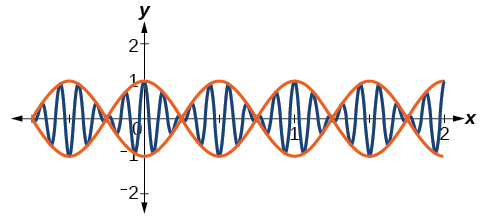-
Home
- Precalculus
- Trigonometric identities and
- Modeling with trigonometric
Bounding curves in harmonic motion
Harmonic motion graphs may be enclosed by bounding curves. When a function has a varying
amplitude , such that the amplitude rises and falls multiple times within a period, we can determine the bounding curves from part of the function.
Visit
this website for additional practice questions from Learningpod.
Key equations
| Standard form of sinusoidal equation |
|
| Simple harmonic motion |
|
| Damped harmonic motion |
|
Key concepts
- Sinusoidal functions are represented by the sine and cosine graphs. In standard form, we can find the amplitude, period, and horizontal and vertical shifts. See
[link] and
[link] .
- Use key points to graph a sinusoidal function. The five key points include the minimum and maximum values and the midline values. See
[link] .
- Periodic functions can model events that reoccur in set cycles, like the phases of the moon, the hands on a clock, and the seasons in a year. See
[link] ,
[link] ,
[link] and
[link] .
- Harmonic motion functions are modeled from given data. Similar to periodic motion applications, harmonic motion requires a restoring force. Examples include gravitational force and spring motion activated by weight. See
[link] .
- Damped harmonic motion is a form of periodic behavior affected by a damping factor. Energy dissipating factors, like friction, cause the displacement of the object to shrink. See
[link] ,
[link] ,
[link] ,
[link] , and
[link] .
- Bounding curves delineate the graph of harmonic motion with variable maximum and minimum values. See
[link] .
Section exercises
Verbal
Explain what types of physical phenomena are best modeled by sinusoidal functions. What are the characteristics necessary?
Physical behavior should be periodic, or cyclical.
Got questions? Get instant answers now!
What information is necessary to construct a trigonometric model of daily temperature? Give examples of two different sets of information that would enable modeling with an equation.
Got questions? Get instant answers now!
If we want to model cumulative rainfall over the course of a year, would a sinusoidal function be a good model? Why or why not?
Since cumulative rainfall is always increasing, a sinusoidal function would not be ideal here.
Got questions? Get instant answers now!
Algebraic
For the following exercises, find a possible formula for the trigonometric function represented by the given table of values.
Questions & Answers
Explain the following terms .
(1) Abiotic factors in an ecosystem
Abiotic factors are non living components of ecosystem.These include physical and chemical elements like temperature,light,water,soil,air quality and oxygen etc
Qasim
passive process of transport of low-molecular weight material according to its concentration gradient
AI-Robot
what is production?
Catherine
how did the oxygen help a human being
how did the nutrition help the plants
Biology is a branch of Natural science which deals/About living Organism.
evolutionary history and relationship of an organism or group of organisms
AI-Robot
cell is the smallest unit of the humanity biologically
Abraham
Got questions? Join the online conversation and get instant answers!
Source:
OpenStax, Precalculus. OpenStax CNX. Jan 19, 2016 Download for free at https://legacy.cnx.org/content/col11667/1.6
Google Play and the Google Play logo are trademarks of Google Inc.


